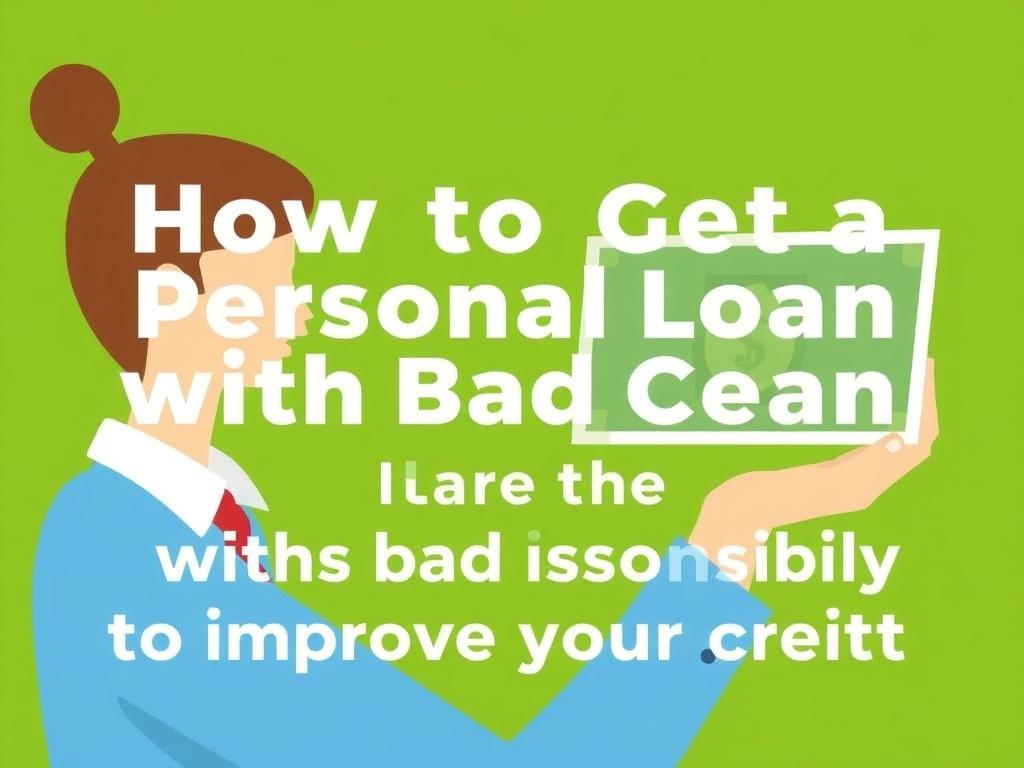SQLITE NOT INSTALLED
Getting a personal loan when you have bad credit can feel like navigating a maze without a map. With a low credit score, many traditional lenders may seem out of reach, leaving you wondering if borrowing money is even an option. The good news is that it’s not impossible. Understanding how to get a personal loan with bad credit is the first step toward securing the funds you need without falling into a financial trap. This detailed guide will take you through the process, share practical tips, and explain how to improve your chances of approval—all while protecting your financial future.
Содержание
Understanding What Bad Credit Really Means
Before diving into the process of applying for a personal loan with bad credit, it’s important to understand what bad credit actually signifies. Your credit score is a number—usually between 300 and 850—that reflects your creditworthiness. It’s calculated based on your payment history, the amount of debt you owe, the length of your credit history, new credit inquiries, and your credit mix. Generally, a score below 580 is considered bad credit. However, each lender may have its own benchmark, so it’s not a fixed number that disqualifies you automatically.
People with bad credit often struggle to qualify for loans with favorable terms. Lenders see them as a higher risk, which usually results in higher interest rates or outright denial of the loan application. But understanding these basics about your credit score and how lenders view it helps you plan and approach the loan application with realistic expectations.
Why You Might Need a Personal Loan Despite Bad Credit
There can be many reasons to pursue a personal loan, even if your credit isn’t in great shape. Some of the most common reasons include:
- Consolidating existing high-interest debts
- Covering unexpected expenses like medical bills or car repairs
- Funding a major purchase or home improvement
- Building or rebuilding credit by demonstrating responsible borrowing
- Handling emergencies when cash flow is tight
Having bad credit doesn’t mean you don’t need financial assistance. It just means you need to be more strategic in how you approach borrowing.
How Lenders View Personal Loan Applications with Bad Credit
When you apply for a personal loan, lenders look beyond just your credit score. They want to understand your overall creditworthiness and ability to repay. Here are some factors they consider:
| Factor | Description | Impact on Loan Approval |
|---|---|---|
| Credit Score | A numerical value representing your credit history. | Low scores increase risk and may lower approval odds or raise interest rates. |
| Income | Your current earnings from employment or other sources. | Higher income shows better ability to repay, improving chances. |
| Debt-to-Income Ratio (DTI) | Percentage of your monthly income that goes toward debt payments. | A lower DTI means you can manage new debt easier. |
| Employment History | How stable and consistent your job situation is. | Stable employment increases lender confidence. |
| Loan Amount and Purpose | How much you want and what you need it for. | Clear and reasonable use of funds can help approval. |
Understanding these factors can help you better prepare your application and highlight your strengths.
Step 1: Check Your Credit Report and Score

Before applying for a personal loan, especially with bad credit, it’s crucial to know exactly where you stand. Obtain your credit reports from the three major credit bureaus: Equifax, Experian, and TransUnion. You can do this for free once a year at AnnualCreditReport.com. Review your reports carefully to spot any errors, outdated information, or fraudulent accounts. Disputing and correcting inaccuracies can sometimes raise your bad credit score enough to improve the terms you’ll be offered.
Knowing your exact credit score allows you to apply where you’re more likely to get accepted. Many online lenders and financial institutions publish minimum credit score requirements, so matching your score with lenders’ criteria can save you time and repeated credit inquiries, which can lower your score temporarily.
Tips for Improving Your Credit Score Quickly
While raising your credit score significantly takes time, some quick measures can help boost it before you apply:
- Pay down credit card balances to lower your utilization rate.
- Make all payments on time, especially on current debts.
- Avoid opening new credit accounts just before applying.
- Dispute and fix any errors on your credit report.
- Keep old credit accounts open to maintain credit history length.
Even minor improvements can make a difference when lenders review your application.
Step 2: Research Lenders That Accept Bad Credit Applicants
Not all personal loan providers are off limits if you have bad credit. There’s a range of lenders catering specifically to borrowers with credit challenges. These include:
- Online lenders: Many online lenders specialize in bad credit personal loans and have more flexible criteria.
- Credit unions: Often more forgiving and willing to work with members who have less-than-perfect credit.
- Peer-to-peer lending platforms: These connect you with individual investors who might be less risk-averse.
- Secured loans: Loans backed by collateral such as a vehicle or savings account.
- Co-signer loans: Having a co-signer with good credit can improve approval chances and loan terms.
Comparing different options allows you to find a loan that’s both accessible and affordable.
Watch Out for Predatory Lenders
Unfortunately, the reality is that some lenders prey on borrowers with bad credit by offering loans with exorbitant interest rates and fees. These loans can trap you in a cycle of debt. Always research a lender’s reputation before applying. Look for clear terms, transparent costs, and customer reviews. Avoid payday loans or loans with hidden fees.
Step 3: Prepare Your Loan Application Carefully

To improve your chances of securing a personal loan with bad credit, preparation is key. Here’s what you need to do:
- Gather documentation: Proof of income (pay stubs, tax returns), identification, proof of residence, and bank statements.
- Calculate your DTI: Knowing your debt-to-income ratio helps you understand how much you can afford to borrow.
- Decide on loan amount and purpose: Request only what you need and be ready to explain why you need the loan.
- Write a personal statement, if applicable: Some lenders accept explanations to supplement bad credit stories, especially for recent financial hardship.
Being organized and transparent shows lenders that you’re serious and responsible.
Step 4: Apply Strategically
Once you’ve researched lenders and prepped your documents, you can start the application process. Here are some strategies:
- Prequalification: Many lenders allow soft credit checks for prequalification, which won’t affect your score.
- Apply first with lenders who target bad credit borrowers: These lenders are more likely to approve your application.
- Limit the number of applications: Multiple hard inquiries can damage your credit score.
- Be honest on your application: Never falsify income or employment information.
Keep track of application deadlines and required documentation to avoid mistakes.
Step 5: Compare Loan Offers and Negotiate Terms
If you get approved for multiple personal loan offers, don’t just accept the first one. Carefully compare interest rates, repayment terms, fees, and penalties. Remember, with bad credit, you might pay higher interest, but some lenders are more reasonable than others. Negotiating is sometimes possible, particularly if you can show recent positive changes in your financial situation.
Key Terms to Look For
| Term | What It Means | Why It Matters |
|---|---|---|
| Interest Rate (APR) | The annual percentage rate charged for the loan. | Lower rates save you money over time. |
| Loan Term | The length of time you’ll repay the loan. | Shorter terms cost less interest but mean higher payments. |
| Origination Fees | Upfront fees charged by the lender. | Increases the effective cost of the loan. |
| Prepayment Penalty | Fees for paying the loan off early. | Limits your ability to save on interest by early repayment. |
Knowing these terms empowers you to make informed decisions.
Step 6: Use the Loan Responsibly to Improve Your Credit

Getting a personal loan with bad credit is not just about immediate cash flow—it’s also an opportunity to rebuild your credit profile. With each on-time payment, you show lenders you can manage debt responsibly. Here are some ways to make the most of your loan:
- Set automatic payments to avoid missed due dates.
- Pay more than the minimum if you can, to reduce principal faster.
- Avoid applying for multiple loans or credit products in a short time.
- Keep your loan balance low relative to the original amount until repaid.
Steady repayment habits will boost your credit score over time, opening doors to better financial products later.
Alternative Options When a Personal Loan Isn’t Available
If obtaining a personal loan with bad credit seems too difficult or expensive, there are alternative strategies you might consider:
- Borrow from family or friends: Informal loans may have better terms but require clear agreements to avoid strained relationships.
- Credit builder loans: These small loans are designed to help you improve credit by making fixed payments.
- Secured credit cards: Use these responsibly to rebuild credit history.
- Negotiating with creditors: Sometimes, creditors allow payment plans or temporary forbearance.
Exploring these alternatives can provide short-term relief while you work on improving your credit profile.
Common Mistakes to Avoid When Applying for Personal Loans with Bad Credit
Many borrowers with bad credit fall into traps that worsen their financial situation. Avoiding these mistakes can save you frustration and money:
- Applying for too many loans at once: This results in multiple hard inquiries and looks risky to lenders.
- Ignoring the fine print: Loans with hidden fees or extremely high interest rates can deepen debt problems.
- Failing to budget for repayments: Taking out a loan without a plan can lead to missed payments.
- Trusting unlicensed or untrustworthy lenders: Always verify lender credentials and read reviews.
- Using the loan for non-essential expenses: Prioritize needs over wants to get maximum benefit.
Being cautious and informed is your best defense.
Conclusion
Getting a personal loan with bad credit might seem challenging, but it is definitely achievable with the right knowledge and approach. By understanding how lenders evaluate your application, improving your credit where possible, researching suitable lenders, and preparing a strong and honest application, you enhance your chances of approval. Remember to compare offers carefully and use the loan responsibly to gradually rebuild your credit profile. If a traditional personal loan isn’t feasible, consider alternative credit-building options and always avoid predatory lenders. With patience, discipline, and smart strategies, you can turn bad credit into an opportunity to improve your financial health and secure the loans you need in the future.
Опубликовано: 23 July 2025 Кредитрон – блог о кредитах, финансах и прочих реверансах
Кредитрон – блог о кредитах, финансах и прочих реверансах

